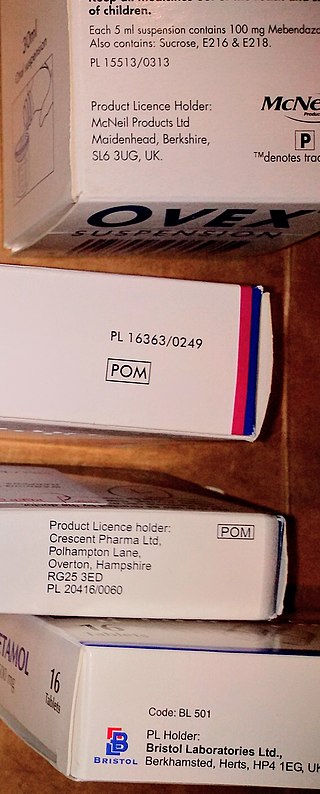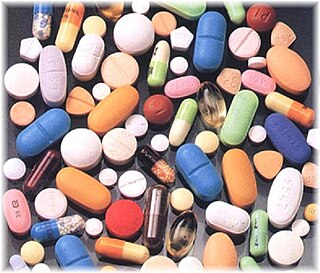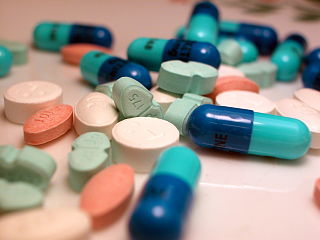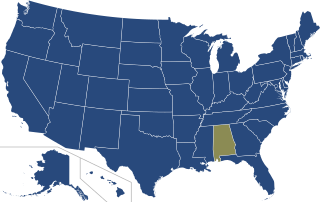Related Research Articles

Over-the-counter (OTC) drugs are medicines sold directly to a consumer without a requirement for a prescription from a healthcare professional, as opposed to prescription drugs, which may be supplied only to consumers possessing a valid prescription. In many countries, OTC drugs are selected by a regulatory agency to ensure that they contain ingredients that are safe and effective when used without a physician's care. OTC drugs are usually regulated according to their active pharmaceutical ingredient (API) rather than final products. By regulating APIs instead of specific drug formulations, governments allow manufacturers the freedom to formulate ingredients, or combinations of ingredients, into proprietary mixtures.

A pharmacist, also known as a chemist or a druggist, is a healthcare professional who specializes in the preparation, dispensing, and management of medications to ensure safe and effective use, while also providing medication counseling and guidance to patients and healthcare providers. Also, pharmacists often serve as primary care providers in the community, and may offer other services such as health screenings and immunizations.

Pharmacy is the science and practice of discovering, producing, preparing, dispensing, reviewing and monitoring medications, aiming to ensure the safe, effective, and affordable use of medicines. It is a miscellaneous science as it links health sciences with pharmaceutical sciences and natural sciences. The professional practice is becoming more clinically oriented as most of the drugs are now manufactured by pharmaceutical industries. Based on the setting, pharmacy practice is either classified as community or institutional pharmacy. Providing direct patient care in the community of institutional pharmacies is considered clinical pharmacy.

A prescription drug is a pharmaceutical drug that is permitted to be dispensed only to those with a medical prescription. In contrast, over-the-counter drugs can be obtained without a prescription. The reason for this difference in substance control is the potential scope of misuse, from drug abuse to practicing medicine without a license and without sufficient education. Different jurisdictions have different definitions of what constitutes a prescription drug.

Rabeprazole, sold under the brand name Aciphex, among others, is a medication that decreases stomach acid. It is used to treat peptic ulcer disease, gastroesophageal reflux disease, and excess stomach acid production such as in Zollinger–Ellison syndrome. It may also be used in combination with other medications to treat Helicobacter pylori. Effectiveness is similar to other proton pump inhibitors (PPIs). It is taken by mouth.

Polypharmacy (polypragmasia) is an umbrella term to describe the simultaneous use of multiple medicines by a patient for their conditions. Most commonly it is defined as regularly taking five or more medicines but definitions vary in where they draw the line for the minimum number of drugs. Polypharmacy is often the consequence of having multiple long-term conditions, also known as multimorbidity. An excessive number of medications is worrisome, especially for older patients with many chronic health conditions, because this increases the risk of an adverse event in those patients.
An adverse effect is an undesired harmful effect resulting from a medication or other intervention, such as surgery. An adverse effect may be termed a "side effect", when judged to be secondary to a main or therapeutic effect. The term complication is similar to adverse effect, but the latter is typically used in pharmacological contexts, or when the negative effect is expected or common. If the negative effect results from an unsuitable or incorrect dosage or procedure, this is called a medical error and not an adverse effect. Adverse effects are sometimes referred to as "iatrogenic" because they are generated by a physician/treatment. Some adverse effects occur only when starting, increasing or discontinuing a treatment. Adverse effects can also be caused by placebo treatments . Using a drug or other medical intervention which is contraindicated may increase the risk of adverse effects. Adverse effects may cause complications of a disease or procedure and negatively affect its prognosis. They may also lead to non-compliance with a treatment regimen. Adverse effects of medical treatment resulted in 142,000 deaths in 2013 up from 94,000 deaths in 1990 globally.
In medicine, patient compliance describes the degree to which a patient correctly follows medical advice. Most commonly, it refers to medication or drug compliance, but it can also apply to other situations such as medical device use, self care, self-directed exercises, or therapy sessions. Both patient and health-care provider affect compliance, and a positive physician-patient relationship is the most important factor in improving compliance. Access to care plays a role in patient adherence, whereby greater wait times to access care contributing to greater absenteeism. The cost of prescription medication also plays a major role.
An independent pharmacy is a retail pharmacy that is not directly affiliated with any chain of pharmacies and is not owned by a publicly traded company. Independent pharmacies are pharmacist-owned, privately held businesses in varying practice settings. They include single-store operations, pharmacist-owned multiple store locations, franchise, compounding, long-term care (LTC), specialty, and supermarket pharmacy operation. Independent pharmacy owners generally have more flexibility to build personalized customer relationships and they strive to differentiate their services from big-chain corporations.

An auxiliary label is a label added on to a dispensed medication package by a pharmacist in addition to the usual prescription label. These labels are intended to provide supplementary information regarding the safe administration, use, and storage of the medication. Auxiliary labels provide information which can augment but not replace verbal counselling from a pharmacist.
Health is the state of complete physical, mental, and social well-being and a positive concept emphasizing social and personal resources, as well as physical capacities. This article lists major topics related to personal health.

Clinical pharmacy is the branch of pharmacy in which clinical pharmacists provide direct patient care that optimizes the use of medication and promotes health, wellness, and disease prevention. Clinical pharmacists care for patients in all health care settings but the clinical pharmacy movement initially began inside hospitals and clinics. Clinical pharmacists often work in collaboration with physicians, physician assistants, nurse practitioners, and other healthcare professionals. Clinical pharmacists can enter into a formal collaborative practice agreement with another healthcare provider, generally one or more physicians, that allows pharmacists to prescribe medications and order laboratory tests.

A pharmacy is a retail shop which provides pharmaceutical drugs, among other products. At the pharmacy, a pharmacist oversees the fulfillment of medical prescriptions and is available to counsel patients about prescription and over-the-counter drugs or about health problems and wellness issues. A typical pharmacy would be in the commercial area of a community.
Urogynecology or urogynaecology is a surgical sub-specialty of urology and gynecology.
Medication therapy management, generally called medicine use review in the United Kingdom, is a service provided typically by pharmacists that aims to improve outcomes by helping people to better understand their health conditions and the medications used to manage them. This includes providing education on the disease state and medications used to treat the disease state, ensuring that medicines are taken correctly, reducing waste due to unused medicines, looking for any side effects, and providing education on how to manage any side effects. The process that can be broken down into five steps: medication therapy review, personal medication record, medication-related action plan, intervention and or referral, and documentation and follow-up.
There are approximately 88,000 pharmacies in the United States. Over half are located within drug stores, grocery stores, hospitals, department stores, medical clinics, surgery clinics, universities, nursing homes, prisons, and other facilities. The remaining pharmacies are considered to be independent or privately owned. The top 25 pharmacy chain stores represent about 38,000 pharmacy locations in the U.S. and employ about 149,000 on-staff pharmacists. California has 8,015 pharmacies, the most of any state. Texas, Florida, New York, and Pennsylvania round out the top five states for pharmacy locations. Nationwide, the number of community pharmacies increased by 6.3% between 2007-2015, and the number of pharmacies per 10,000 people (2.11) did not change. However, the number of pharmacies per-capita varies substantially across counties, ranging from 0 to 13.6 per- 10,000 people in 2015.
Psychiatric pharmacy, also known as mental health pharmacy, is the area of clinical pharmacy specializing in the treatment of people with psychiatric illnesses through the use of psychotropic medications. It is a branch of neuropsychiatric pharmacy, which includes neurologic pharmacy. Areas where psychiatric pharmacists are found most abundantly are in chemical dependency, developmental disabilities, long-term care facilities, adherence clinics, mental health clinics, and within the prison system. However, psychiatry and neurology are not the only areas where psychiatric pharmacists require comprehensive knowledge. They must also be proficient in clinical problem solving, interprofessionalism, and communication with understanding and empathy for the patient population they serve, as they are a sensitive group.

Deprescribing is described as a patient-centred process to taper or stop medications with the intention to achieve improved health outcomes by reducing exposure to medications that are potentially either harmful or no longer required. Deprescribing is important to consider with changing health and care goals over time, as well as polypharmacy and adverse effects. Deprescribing can improve adherence, cost, and health outcomes but may have adverse drug withdrawal effects. More specifically, deprescribing is the planned and supervised process of intentionally stopping a medication or reducing its dose to improve the person's health or reduce the risk of adverse side effects. Deprescribing is usually done because the drug may be causing harm, may no longer be helping the patient, or may be inappropriate for the individual patient's current situation. Deprescribing can help correct polypharmacy and prescription cascade.

A collaborative practice agreement (CPA) is a legal document in the United States that establishes a legal relationship between clinical pharmacists and collaborating physicians that allows for pharmacists to participate in collaborative drug therapy management (CDTM).

The pharmacy management system, also known as the pharmacy information system, is a system that stores data and enables functionality that organizes and maintains the medication use process within pharmacies.
References
- 1 2 Taylor, Jeff. "OTC Counseling: Review of Pharmacists Performance". Medscape.com. WebMD LLC. Retrieved 21 July 2017.
- 1 2 3 4 Dinkins, MM. "Patient Counseling: A Pharmacist in Every OTC Aisle". uspharmacist.com. Jobson Medical Information LLC. Retrieved 24 July 2017.
- ↑ Clinical Pharmacy Department Staff (2008–2009). "Community Pharmacy and Pharmacy Practice". slideshare.net. Cairo University. p. 140. Retrieved 30 July 2017.
- ↑ "Over-The-Counter Medications Time Tool Clinical Reference". acpm.org. American College of Preventive Medicine. Retrieved 24 July 2017.
- 1 2 Calemine, Larry. "8 Things a Pharmacist Should Know to Counsel Patients with Cancer". pharmacytimes.com. Pharmacy & Healthcare Communications, LLC. Retrieved 24 July 2017.
- 1 2 3 4 Ferreri, Stefanie (December 2004). "Out From Behind the Bench: Quick and Effective OTC Counseling". Pharmacy Times. Pharmacy & Healthcare Communications, LLC. Retrieved 12 May 2017.
- 1 2 3 4 "Pharmacy Mnemonics: WWHAM, ASMETHOD, ENCORE and SIT DOWN SIR". resourcepharm.com. 4 Pharm Ltd. Retrieved 24 July 2017.
- ↑ Leibowitz, K; Ginsburg, D (2002). "Counseling self-treating patients quickly and effectively". Proceedings of the APhA Inaugural Self-Care Institute.
- ↑ "Using the WWHAM Pathway in pharmacy to open up a sensitive conversation with patients". blog.boehringer-ingelheim.co.uk. Boehringer Ingelheim. November 13, 2015. Retrieved 26 July 2017.
- 1 2 3 Blenkinsopp, Alison; Paxton, Paul; Blenkinsopp, John (27 March 2013). Symptoms in the Pharmacy: A Guide to the Management of Common Illness (6 ed.). ISBN 978-1118598443.
- ↑ Clinical Pharmacy Department Staff (2008–2009). "Community Pharmacy and Pharmacy Practice". slideshare.net. Cairo University. p. 7. Retrieved 30 July 2017.
- 1 2 Boardman, HF; Heeley, G (October 2015). "The role of the pharmacist in the selection and use of over-the-counter proton-pump inhibitors". Int J Clin Pharm. 37 (5): 709–716. doi:10.1007/s11096-015-0150-z. PMC 4594082 . PMID 26100836.
- ↑ Boon, H; Hirschkorn, K; Griener, G; Cali, M (February 2009). "The Ethics of Dietary Supplements and Natural Health Products in Pharmacy Practice: A Systematic Documentary Analysis". Int J Pharm Pract. 17 (1): 31–38. doi:10.1211/ijpp.17.1.0005. PMC 2918535 . PMID 20218027.
- ↑ Kreckel, Peter (February 2018). "Pharmacists and Vitamins". DrugTopics. 162 (2): 32.
- ↑ Elavsky, Megan (February 2018). "Urinary Incontinence: What Pharmacists Should Know". DrugTopics. 162 (2): 26–27.